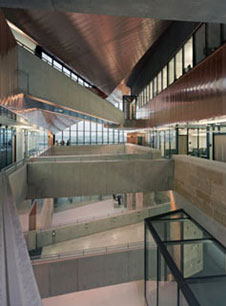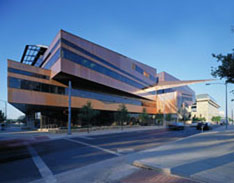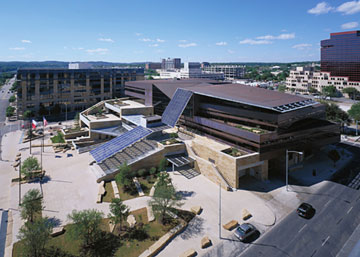Completed in 2004, Austin’s City Hall is a distinctive Green Building. Designed by Antoine Predock to reflect its natural surroundings, the four-story 118,000-sq-ft structure incorporates local limestone, a cascading waterfall and nonsymmetrical shapes, all of which reflect the waterways and canyons of Austin’s surroundings. Copper (installed by Kidd Roofing) clads the building’s top two floors, roof and its “stinger,” which projects 50 feet out over a neighboring street. The building’s unique and somewhat controversial design is anchored by a number of very practical and meaningful features designed to meet the goal of portraying transparent government while providing a meeting space for the continual benefit of the city of Austin.
The Building

Inside City Hall, the bronze ceiling reflects light downward
Photo courtesy Antoine Predock
The building is set slightly askew from the street. The spaces around it include a large open plaza, a limestone stage and amphi- theater seating shaded by photovoltaic panels. These design elements facilitate and complement the city’s casual style and love of live music. The project serves numerous purposes in the city’s life and culture beyond simply housing its administration.
Entering the building, visitors find themselves standing in a canyon-like space that reaches four stories to a reflective bronze ceiling. Catwalk-like bridges span the openness at each level. The city council chamber has theater-style seating for 156, with monitor screens inside the chamber and in the lobby to allow public viewing of council proceedings.
What Makes It Green?
LEED Gold
When the City Hall project was initiated, all of those involved were committed to achieving a LEED rating. According to Deb Ebersole of Cotera+Reed Architects, this was done because “it’s the right thing to do, Austin has always been green, and this is a good way to compare ourselves to others.” The U.S. Green Building Council recognized their success and awarded the building a LEED Gold certification.
Material Reuse
More than 50% of the construction waste was diverted from landfills, with appropriate pieces of ceramic tiles, wood and concrete going to local artists and schools. The designers provided for recycling the condensate generated by the air conditioning to feed a waterfall that streams into the south plaza. Many of the materials used throughout the project, including copper, steel, drywall and concrete masonry had high levels of recycled content.
Minimal Energy Use
Large, mature trees are planted to shade the building. An underground parking garage reduces the building’s footprint and the amount of reflected heat that would have been generated by a street level lot.
The building is part of Austin Energy’s Downtown District cooling system, which generates ice overnight when electricity is cheaper and demand is lower. The ice is used to chill the water that cools the building. The city purchases 50% of the building’s energy needs from renewable sources through Austin Energy’s Green Choice program, which relies primarily on wind-generated power.
User Considerations
The provision of showers and changing rooms encourages alternative forms of commuting. And, by using paints, carpets and adhesives with low to no volatile organic compounds (VOCs), indoor air quality is dramatically better than average. Solar panels over the main stairs act as a design feature, a power source and a means of shade for people watching events in the plaza.
Copper's Role
Outside

The copper-clad city hall and 50-foot “stinger”
Photo courtesy Antoine Predock
Some 66,000 square feet, or more than a football field’s worth, of copper is used primarily to wrap the top half of the building, including the “stinger.” The 12-inch-wide copper-clad panels and standing seam copper roof have been treated with a light oil coating to slow their patination. Due to the low amount of sulfur in Austin’s air, it is expected that the copper will turn first to various shades of brown and then to a soft grey with hints of blue and green in about 30 years. Alongside the importance of the coloring is the fact that copper can be fitted to almost any shape. This was critical because the building has few 90-degree angles.
The copper cladding on the outside of the building will last two to three times longer than other exterior materials, resulting in the consumption of from a third to a half less material over the building’s lifetime.
Inside
In the lobby, a bronze ceiling reflects the sun coming in from the skylight into the space below. In the council chamber, 16 corrugated “copper clouds” dominate the ceiling, acting as both design features and acoustical panels. Finally, the fact that the copper has 82% recycled content helped contribute to its award of the LEED point for using recycled materials.
Further, the only energy needed to make cladding from recycled copper is for the heat to melt it — just 15% of the total energy that would have been consumed if it had been mined, milled, smelted and refined from ore. This translates into big energy savings, as more than 80% of the copper used to make architectural sheet products is derived from recycled copper.
Finally, copper cladding will last two or three times longer than other exterior materials, resulting in the consumption of from a third to a half less material over a building’s lifetime.
Up-to-date and Useful
The city took advantage of the opportunity of building a new city hall to ensure it would be technologically up-to-date and to ensure the building’s usefulness to a wide variety of users. More than 150 miles of copper cabling was used to route power and control as well as audio, video and computer communications. At the end of use, all of this copper cable can be recycled into other copper and brass products, like plumbing tube, cladding and hardware — all of which have an average recycled content of between 65% and 95%.

Austin City Hall from above, showing the copper roof and photovoltaic cover over the amphitheater seating
Photo courtesy Antoine Predock
Meeting Multimedia Needs
The designers worked closely with the local media and the city’s own news channel to make the building “media friendly” and able to meet future needs. Studio lighting was installed, as well as audio and video plug-ins throughout, allowing live broadcasts from almost anywhere. An extensive sound system was installed, so all could enjoy the live music performed before every council meeting. Both wired and wireless access to the Internet is also available throughout the building, so city hall staff and the public can access information wherever and whenever they need it.
Conclusion
The adventurous designer Antoine Predock did not hold anything back on Austin’s city hall, despite the clear goal of achieving LEED certification. The result is a unique green building in which copper contributed significantly to the many features that make it functional, aesthetically pleasing and environmentally beneficial. This includes the copper cladding that wraps the upper two floors and the roof of the building, the copper ceiling and interior wall panels, the copper acoustic panels in the council chamber, and the many miles of copper cabling used to support the technological features of the building. This building shows how environmental and aesthetic qualities can work in harmony and pave the way forward for the future of cutting edge design.
